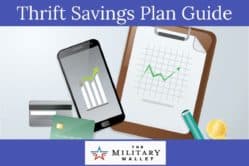Table of Contents
- What are the Rules for a Financial Hardship Withdrawal?
- What Happens After the Hardship Withdrawal?
- What is the Cost of a Financial Hardship Withdrawal?
- TSP Hardship Withdrawals: Pros & Cons
- Is a TSP Hardship Withdrawal Right for You?
- Is a Hardship Withdrawal Worth It?
- Qualified Reservist Distribution – TSP & IRA Withdrawals for Reservists
- Early Withdrawal Penalties and How to Avoid Them
- Qualified Reservist Distribution – How Mobilized Reservists Can Take Penalty-Free Early Withdrawals
The Thrift Savings Plan (TSP) has a feature that allows its members to withdraw money during a financial emergency. While this can be helpful in a tight situation, it is not a decision to take lightly. When money is taken out early, it cannot be replaced in the TSP, and you will lose out on any potential growth from those funds.
The TSP is designed similarly to a 401(k) plan, long-term retirement savings plan with tax deferral advantages. It is not designed to be a temporary savings account, or to be tapped into before you are normally eligible, which is age 59 1/2. To deter people from taking early withdrawals, taxes and penalties are assessed in addition to the inability to replace withdrawn funds. Strict restrictions are also in place to determine who is eligible for early withdrawals.
What are the Rules for a Financial Hardship Withdrawal?
TSP members only qualify for financial hardship withdrawals if the federal government still employs them. The amount of the financial hardship withdrawal is limited to your financial need, but you cannot withdraw less than $1,000. You may be able to withdraw both your contributions and earnings, but as previously mentioned, you cannot replace any of these funds once they are withdrawn.
To be eligible for a hardship withdrawal, your financial need must result from any of these 4 conditions:
- Negative Monthly Cash Flow: To determine negative cash flow, one can utilize the worksheet provided with the Financial Hardship Withdrawal Request (Form TSP-76). You do not have to return the worksheet with your request for a financial hardship withdrawal. However, you will be required to affirm under penalty of perjury that you have a genuine financial hardship and the reason for the hardship. Maintaining a copy of this form for your records is a good idea.
- Medical Expenses (including household improvements needed for medical care)
- Personal Casualty Losses
- Legal Expenses for Separation or Divorce
Other Ways the IRS Prevents TSP Hardship Abuse
The IRS has other rules you’ll need to follow before making a hardship withdrawal from your Thrift Savings Plan.
- The withdrawal must meet an immediate and heavy need: This stipulation helps define hardships as current and serious problems and not anticipated or minor problems.
- The withdrawal must be the only option available to meet the need: Have other options to solve the problem? You should exhaust those first.
- The withdrawal must satisfy the need. Amounts above the need are not permitted: You can’t withdraw a little extra to smooth things over for a few months. The withdrawal must be used exclusively for the specified hardship.
- The withdrawal cannot come before all non-taxable distributions or loans have been obtained from the TSP: You’ll have to wait until after you’ve gotten your scheduled distributions (if you’re old enough to receive distributions) before seeking a hardship withdrawal.
What Happens After the Hardship Withdrawal?
Besides the inability to ever repay the funds you withdrew from your TSP account, you cannot contribute to your TSP account for 6 months. If you participate in FERS, you will not receive any Agency Matching Contributions when you are not eligible to contribute to the TSP. You will, however, continue receiving your agency’s automatic (1%) contribution.
After the 6-month waiting period, you must change your contribution election form if you wish to resume contributions. You will not be able to apply for another financial hardship withdrawal request until 6 months have passed.
What is the Cost of a Financial Hardship Withdrawal?
A lot. Your future retirement income will be permanently diminished by the amount you withdraw, plus the earnings you may have realized on your investment. The other consideration is taxes and penalties.
Taxes on the Amount Withdrawn
Your withdrawal is subject to Federal income tax, and may also be subject to state income tax as well. The TSP will automatically withhold 10% of the funds you withdraw unless you instruct them to withhold a different amount.
Early Withdrawal Penalties
If you are less than 59 ½ when you make the withdrawal, you may be subject to a 10 percent early withdrawal penalty tax in addition to the income tax.
6 Month Pause on New Contributions
In addition, if you are a FERS employee, you will also not receive any matching contributions because you will not be making employee contributions. You will continue to receive the automatic 1%, but you will be leaving a lot of other funds on the table and will never be able to recover them.
TSP Hardship Withdrawals: Pros & Cons
Like any important financial decision, you should take a few minutes to consider the pros and cons of making a 401(k) hardship withdrawal.
Advantages of a Hardship Withdrawal
The advantage of making a hardship withdrawal is clear and simple: You can access your money in a qualifying emergency.
This can prevent the hardship from worsening and keep you from seeking solutions like loans or credit cards which often come with high-interest rates.
Also, unlike a TSP loan, hardship withdrawals do not have to be repaid into your 401(k) account so you won’t be adding another monthly loan payment to your budget.
Drawbacks of Hardship Withdrawal
Even when you have a great reason to withdraw money from your 401(k) before retiring, the fact remains that you are taking a distribution from your retirement account for purposes other than retirement.
By taking money out of your account now, you’re preventing that money from growing into the future, which is one of the main reasons to have a 401(k) account.
And hardship withdrawals are not free. Treated as a distribution, the hardship withdrawal is subject to income tax and the 10% early withdrawal penalty if you are not at least age 59 1/2.
Is a TSP Hardship Withdrawal Right for You?
Will the short-term benefits of taking money from your retirement account outweigh the long-term consequences?
Only you can answer that. As a general rule, tapping into retirement savings should be avoided whenever possible.
But hardship withdrawals exist for a reason. If you’ve determined the withdrawal makes sense for your situation, you can proceed as you see fit.
Scenarios When Withdrawing Makes More Sense
Only you can know your precise situation, but here are some scenarios in which a hardship withdrawal may make more sense:
- If you expect a sizeable tax refund and can more easily absorb the taxes, you’d be assessed on the withdrawn money.
- If your monthly budget simply won’t allow the addition of another loan payment from either a TSP loan or a commercial loan from your bank or credit union.
- The money you’re saving in your TSP account represents a less significant portion of your retirement plan. If, for example, most of your retirement savings are in other investments you can’t access.
- If you’re 59-½ years old or older since you can avoid the 10 percent distribution penalty.
- If you’re permanently disabled and can withdraw money penalty-free (though not tax-free).
Scenarios When Withdrawing Makes Less Sense
Again, your situation is unique, and you should treat it that way, but here are some times when hardship withdrawals may make less sense or be ill-advised:
- If you are filing for bankruptcy: You should leave your TSP money alone since your TSP account could shield those assets from seizure. Your bankruptcy attorney should advise you about these specifics.
- If you have not saved or planned for retirement other than your TSP account.
- If you already expect to owe taxes next year and are unsure how you’ll pay them.
- If you are younger than 59-½ years old and would lose an additional 10 percent of the withdrawal in penalties.
Weigh your options carefully and look at your individual needs, both current and future, as you make this decision.
Is a Hardship Withdrawal Worth It?
In the most urgent cases, you can probably justify it. But because you will have to pay taxes, possibly a lot in penalties, and limit the potential for the growth of your retirement funds, this may not be the best option. I would strongly consider applying for a loan before paying these taxes and penalties. As with everything, your situation is unique, and you should consult a professional financial advisor before deciding whether or not to pursue this avenue.
Qualified Reservist Distribution – TSP & IRA Withdrawals for Reservists
Did you know that Reserve and National Guard servicemembers can make penalty-free withdrawals from their IRAs?
Ed Slott has been the national expert on IRAs for over a decade and has the credibility to offer this advice from the IRS IRA regulations. A “Qualified Reservist Distribution” allows withdrawals from tax-deferred accounts like IRAs, 401(k)s, 403(b)s, and others.
Early Withdrawal Penalties and How to Avoid Them
Most retirement plans have a 10% early withdrawal penalty if you make withdrawals before age 59 1/2. This is in addition to any other taxes you may have to pay (which you will if it is a Traditional retirement account).
Some people know that there are exceptions to the penalty when the early withdrawal is for death, disability, and certain medical expenses. Some accounts also allow participants to begin penalty-free withdrawals at age 55 if their separation from their employer came on or during the year they turned 55.
Rule 72(t) also requires participants to take substantially equal periodic payments (SEPPs) over a minimum of 5-years. There are very strict IRS guidelines outside this article’s scope.
Many people also know that a first-time homebuyer can take a Roth IRA withdrawal.
But few people (me included) have heard about QRDs.
Qualified Reservist Distribution – How Mobilized Reservists Can Take Penalty-Free Early Withdrawals
Here are the requirements:
- be mobilized after 11 September 2001 for at least 180 days, or for an indefinite period,
- take the distribution during that period
Yes, you can also make a QRD from your Thrift Savings Plan account. (See page 7 of that PDF.)
Remember that even when you can make a QRD, you should only do so as a last resort. It’s intended to help with temporary cash flow problems during mobilization, and you’re essentially cannibalizing your retirement income for today’s financial emergency.
It’s better than taking on credit-card debt, but it’s also a sign of a financial problem that has to be addressed and corrected. You should have an adequate emergency fund for deployment surprises, and ideally, you’d return the money to your retirement account as soon as the problem is dealt with.
You’ll still pay regular income taxes on the withdrawal, but there will be no penalty.
Even better, if you decide you didn’t need the withdrawal, you can repay the QRD to your IRA within two years of the withdrawal. Read those links for more details and consult with a tax advisor before you try this at home.




Comments:
About the comments on this site:
These responses are not provided or commissioned by the bank advertiser. Responses have not been reviewed, approved or otherwise endorsed by the bank advertiser. It is not the bank advertiser’s responsibility to ensure all posts and/or questions are answered.
Betty says
I am a Widow of a 9yr Veteran of Vietnam. He passed away 100% Permanent and total. I have the home loan benefit but I am unable to find a Morgage Company. For 2 years the IRS notified me someone was using my identity to file taxes. Then I received Notification for a Medical Insurance Billing Company that a Company called AMCA had sold my information to the Dark Web. They have destroyed my life Three years ago I had a savings account of over $17,000. I was hit by Google.com and Amazon.com for over $7,000. My bank refunded less than a fourth. I have a rare bone marrow disease which led to the amputation of my right leg. I have been homeless for over 6 months now. I have no home to put my Hospital bed in. I have legal DOCUMENTED proof of everything I am telling You. I have made claims with every Government Agency I can find. My credit is ruined. I am a Victim and I can’t believe Our Government can’t do anything to help me.My Husband gave his life fighting for Our Nation and this is how his Widow is treated.
Thank You for Your time
Betty J Beech
Claim Id# 440-46-6535
[email protected]
865-643-0549
Brittany Crocker says
Hey Betty, I’m really sorry to hear all of this. If you haven’t yet, definitely reach out to the Federal Trade Commission to report the identity theft at 877-438-4338. I saw your phone area code is in Knoxville. If you live in Knoxville, the local community action committee’s social services might be able to point you in the right direction. Their number is 865-546-3500. Or, you can reach out the their seniors office at (865) 524-2786. Additionally, a VA case worker told me you can reach out to the Mountain Home VA’s homelessness office at 865-545-4592 SW Homeless program. If that number doesn’t work you can try 888-313-5421 and ask for the VA homelessness team. You’ll need to provide some information about your husband, but they should be able to help you out.
I hope these resources can help you!